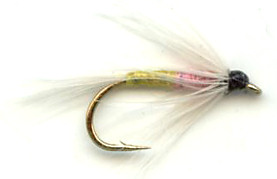Tup's Indispensable Soft Hackle
How do you fish for trout using a Tup's Indispensable Soft Hackle wet Fly. I like to fish them in a team of three. If it is windy then I weight the point fly

SOFT HACKLE NORTH COUNTRY SPIDER WET FLY PATTERNS. Hook size 12 14 - $US each
How to fish a Tup's Indispensable Soft Hackle wet Fly
When you fish the upper reaches of a river the velocity of the water is normally faster than in lower stretches because of the restricted width and altitude above sea level. So how does that effect fly fishing tactics? The trout, though not huge, are mighty fighters. They have to be to survive in such fast moving water. These fish look for protection from the current by waiting in the tiny pockets of quieter water behind boulders, tree logs, shelves and protected pools. They wait for food to drift past their position rather than go actively hunting for it. Your casting must be pin point accurate to enable your flies to drift past the most obvious trout resting locations. In these conditions I use a long 10 foot rod to help twitch the line around rocks and give a fast lift to match the current. I like to use a three fly team of soft hackles in these conditions. In windy conditions I add weight to the point fly to help it battle through the gusts of air. Three normal soft hackle flies would just flutter around during a normal cast against the wind.
Mr R.S.Austin was a tobacconist in Tiverton in Devon, South West England. He also tied and sold fishing flies as a sideline. Mr Austin sent a sample of dubbing with tying instructions on how to tie an unnamed fly pattern which he had found particularly successful in imitating female olive spinners to Mr G.E.M. Skues, father of modern nymph fishing. Skues followed the instructions and made the fly. He spent most of the following September testing the fly on his local water the River Ichen and was so impressed that he published his findings. He also found it was a very effective imitation of a Pale Watery natural insect. He is accredited with naming the fly and suggesting the addition of the crimson seal fur giving the thorax a pinkish hue. The recipe for the pattern was kept secret and thus Mr Austin obtained a monopoly on selling the fly. The article was widely read and lots of orders were placed.
"The fly became so popular that Mr Austin became utterly sick of tying it," Skues wrote in a letter. He was one of two people given the dressing secret by Mr Austin. It was kept a secret until after his daughter, who continued the business, had retired. Why is it called Tup's Indispensable? Well the "Indispensable" part comes from the fact that it should not be left out of your fly box as it is such a good fish taker. The "Tup's" part of the flies name refers to a Ram, a male sheep that is used for breeding. In Britain farmers use a sponge or rag soaked in dye tied to the under side of the Ram. In the morning they inspect their flock and see which females have dye stained backs from being "tupped" by the Ram. The original material for this fly was urine and dye stained wool taken from a ram's fleece mixed with lemon colored fur from a spaniel and a little yellow mohair, replaced later with crimson seal's fur. Do not panic! We use modern materials that are the same color but not as smelly.


Fly Fishing books

